List of equipment of the Austrian Army
This is a list of equipment used by the Austrian Army.
Equipment
| Name | Origin | Type | Calibre | Quantity | Photo | Notes |
|---|---|---|---|---|---|---|
| Assault rifle and battle rifle | ||||||
| StG 77 | Assault rifle | 5.56×45mm | Service rifle, 3 variants
Sturmgewehr 77 (StG 77), StG 77 A2, StG 77 KPE | |||
| StG 58 | Battle rifle | 7.62×51mm | 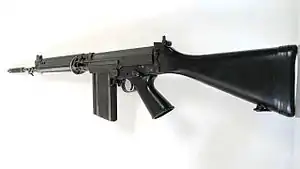 |
Sturmgewehr 58 (StG58). Former service rifle, now used as a ceremonial weapon by Austrian Guard Companies | ||
| Pistol | ||||||
| Glock 17 | Semi-automatic pistol | 9×19mm |  |
Pistole 80 (P80), service pistol | ||
| Glock 26 | Semi-automatic pistol | 9×19mm | .jpg.webp) |
|||
| Sniper rifle | ||||||
| Steyr SSG 69 | Sniper rifle | 7.62×51mm | Scharfschützengewehr 69 (SSG69) | |||
| Steyr SSG 08 (M1 variant) | Sniper rifle | .338LM | .jpg.webp) |
SSG M1, fitted with Kahles K624i scope sight, sound suppressor[1][2] | ||
| Machine gun | ||||||
| MG 74 | Machine gun | 7.62×51mm | 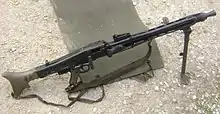 |
Maschinengewehr 74 (MG74) | ||
| FN MAG | Machine gun | 7.62×51mm | .jpg.webp) |
Turmdachmaschinengewehr MAG (MAG MG). Only used on Leopard 2A4 tanks, Ulan tanks and Black Hawk helicopters | ||
| üsMG M2 | Machine gun | .50 BMG | 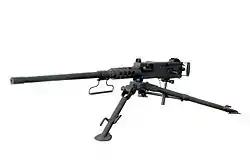 |
Überschweres Maschinengewehr M2 (üsMG M2), heavy machine gun | ||
| Anti-tank weapon | ||||||
| Carl Gustav recoilless rifle | Anti-tank weapon | 84 mm | 1,000[3] | 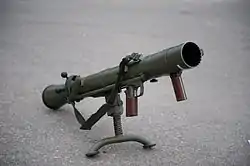 |
Panzerabwehrrohr 66/79 (PAR 66/79) | |
| BILL 1 Anti-tank guided weapon | Anti-tank weapon | 150 mm | 400[3] | .jpg.webp) |
Panzerabwehrlenkwaffe 2000 (PAL2000) | |
| Grenade launcher | ||||||
| Steyr GL 40 | Grenade launcher | 40 mm | .jpg.webp) |
|||
| Mortar | ||||||
| Hirtenberger M6C-210 | 60mm mortar | 60 mm | 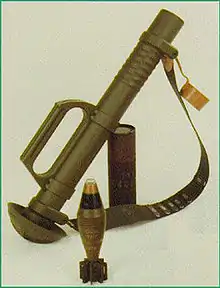 |
|||
| mGrW 82 | 81mm mortar | 81 mm | 100 (est.)[3] | 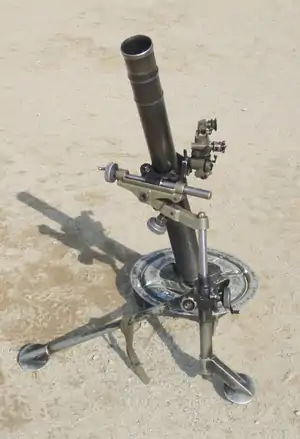 |
Mittlerer Granatwerfer 82 (mGrW 82) | |
| GrW 86 | 120mm mortar | 120 mm | 200[3] | .jpg.webp) |
Schwerer Granatwerfer 86 (sGrW 86), heavy mortar | |
| Special forces | ||||||
| Steyr TMP | Submachine gun | 9×19mm |  |
|||
| FN P90 | Submachine gun | 5.7×28mm | .jpg.webp) |
|||
| Remington 870 | Pump-action shotgun | 12 gauge | ||||
| Steyr AUG A3 SF | Assault rifle | 5.56×45mm | .jpg.webp) |
|||
| Steyr HS .50 | Anti-materiel rifle | .50 BMG |  |
|||
| Barrett M82 | Anti-materiel rifle | .50 BMG | ||||
| Barrett M95 | Anti-materiel rifle | .50 BMG | 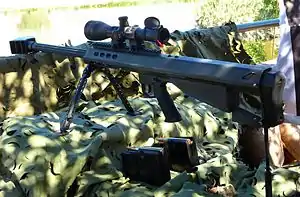 |
|||
Vehicles
| Name | Origin | Type | Number | Photo | Notes |
|---|---|---|---|---|---|
| Armoured vehicle | |||||
| Leopard 2A4 | Main battle tank | 56 | _(cropped).jpg.webp) |
Replaced the M60 A3 in 1997[4] | |
| Ulan | Infantry fighting vehicle | 112[3] |  |
Replaced the Schützenpanzer A1 in the mechanized infantry | |
| Pandur I Pandur EVO |
Armoured personnel carrier | 71[3] 64 |
.jpg.webp) |
All Pandur I APCs have been upgraded with a new remote weapon station. Three Pandur I are ambulance APCs. 6 APCs and 1 ambulance APC to be delivered from Belgium from 2016.
1 Pandur EVO to was delivered in 2020 + 30 Pandur EVOs ordered additionally..[5] | |
| Dingo 2 | Infantry mobility vehicle | 75[3] | 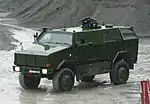 |
60x Dingo 2 ATF (Standard), 12x Dingo 2 AC NBC reconnaissance and 3x Dingo 2 AC ambulance + 40 be delivered from September 2018 | |
| MAN TGS 38.440 8x8 | Military logistics vehicle | 24 | .jpg.webp) |
||
| Iveco LMV | Light utility vehicle | 172[3] |  |
||
| BvS 10 | Armoured personnel carrier | 32 |  |
First vehicles delivered in 2019 | |
| Armoured recovery vehicle | |||||
| Bergepanzer M 88A1 | Armoured recovery vehicle | 10[3] |  |
||
| Bergepanzer Greif | Armoured recovery vehicle | 39[3] | .jpg.webp) |
||
| Engineering vehicle | |||||
| Pionierpanzer A1 | Armoured engineering vehicle | 19[3] |  |
||
| Faltstraßengerät | Truck | 13 | 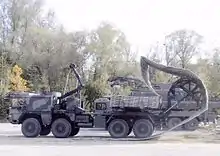 |
Folding-Road Laying System (50m) | |
| Pionierbrücke 2000 | Bridging vehicle | 6 |  |
Dornier Foldable Bridge (40m) | |
| Kaiser Schreitbagger SX | Walking excavator |  |
|||
| Hydrema 910 MCV-2 | Mine flail | 2[6] | 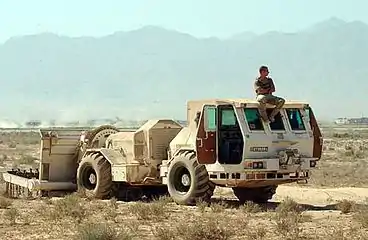 |
In service as Minenräumsystem mittel; for testing[6] | |
| DOK-ING MV-4 | Remote-controlled mine flail |  |
In service as Minenräumsystem leicht[6] | ||
| Unarmoured vehicle | |||||
| Puch G 4x4 | Light utility vehicle |  |
|||
| Puch G 290/LP "Sandviper" | Special forces vehicle | .jpg.webp) |
|||
| Pinzgauer | Light utility vehicle |  |
|||
| Mitsubishi Triton | Light utility vehicle | 300 | _GLX-R_4-door_utility_(2007-10-12)_02.jpg.webp) |
||
| Bandvagn 206 | Tracked all-terrain carrier | 1 | .jpg.webp) |
||
| Polaris ATV | All-terrain vehicle | 72 | .jpg.webp) |
To be delivered from 2016 | |
| Unimog | Truck | 268 |  |
||
| MAN TGM 12.240 4×4 BL | Truck | 307 | |||
| Steyr 12 M 18 | Truck | 1,000 | .jpg.webp) |
Basis of the United States Armed Forces FMTV | |
| ÖAF SLKW | Truck | 240 | 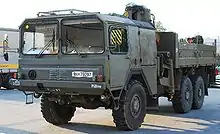 |
||
| Aufklärungs- und Zielzuweisungsradar (AZR) RAC 3D | Truck | 24 |  |
||
| MAN lion’s coach | Personnel carrier | 6 | |||
| Man R07 | To be delivered 2021 | ||||
| Artillery and air-defence | |||||
| M109 A5Ö Rechenstellenpanzer M-109 |
Self-propelled howitzer | 32 30[3][7] |
 |
[8][9] | |
| Zwillingsflugabwehrkanonen 35 mm (ZFLAK 85) | Anti-aircraft gun | 12 | .jpg.webp) |
Reduced from 18 to 12 pieces | |
| Mistral missile | Surface-to-air missile | 34 | .jpg.webp) |
40 in storage | |
| Man Lions’s coach | |||||
Aircraft
| Name | Origin | Type | Number | Photo | Notes | |
|---|---|---|---|---|---|---|
| Fighter aircraft | ||||||
| Eurofighter Typhoon | Multirole fighter | 15[3] | 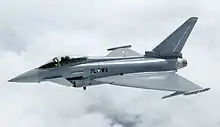 |
To be replaced by 15 new single-seater and 3 two-seater aircraft from 2020 on due to high operating costs | ||
| Transport aircraft | ||||||
| Lockheed C-130 Hercules | Military transport aircraft | 4 | .jpg.webp) |
4th one delivered in 2015[10] | ||
| Pilatus PC-6B Porter | STOL passenger and utility aircraft | 8[3] | .jpg.webp) |
|||
| Attack- and trainer aircraft | ||||||
| Pilatus PC-7 Turbo Trainer | Military trainer aircraft, attack aircraft | 12[3] | .jpg.webp) |
|||
| Trainer aircraft | ||||||
| Diamond DA40 | Military trainer aircraft | 4[11] |  |
4 delivered in 2018 | ||
| Helicopters | ||||||
| Sikorsky UH-60 Black Hawk | Utility helicopter | 9[3] | .jpg.webp) |
3 to be delivered in 2021 | ||
| Bell OH-58 Kiowa | Scout helicopter | 10[3] | .jpg.webp) |
To be replaced in 2030 | ||
| Bell 212 Twin Huey | Troop transport, equipment transport helicopter | 23[3] | .jpg.webp) |
Made by Agusta, Italy | ||
| Aérospatiale Alouette III | Rescue and transport helicopter | 21[12] |  |
Scheduled to retire in 2020 | ||
| Leonardo AW169M | Attack helicopter (4) Rescue and transport helicopter (8) Training and rescue/transport helicopter (6) |
18[13] | To be delivered in 2022 | |||
| Unmanned aerial vehicles | ||||||
| EADS Tracker | Unmanned aerial vehicle | 18[3] | ||||
Watercraft
| Name | Origin | Function | Photo | Number | Notes |
|---|---|---|---|---|---|
| Arbeits- und Transportboot[14] | Troop transport, equipment transport | ? | |||
| Marine Alutech Watercat M9[15] | Patrol boat | 20 | In service as "Sturm- und Flachwasserboot" | ||
| ALU Pi-Boot[16] | Troop transport, equipment transport | 80+ |
Heavy armored/weaponed ships:
The Austrian military operated a naval squadron until 2006. However the two ships are still part of the equipment of the armed forces and can be used in need, but there are no soldiers who train with the boats actively.
| Crew | 9 men (1 squadron commander, 1 ship commander, 1 helmsman, 1 machinist, 3 sailors, 2 machine assistants) |
| Weights and measures | Length: 29.67m
Width: 5.41m Draft: 1.1m Operating weight: 73t |
| Motorization | 2 diesel turbochargers, V16 with 810PS each
Construction speed: 41km / h |
| Weapons | 1 automatic cannon MK 66, cal.2cm
1 heavy machine gun, cal. 12.7mm 1 MG 74 machine gun, cal. 7.62mm 1 anti-tank tube PAR 66, cal. 8.4 cm 9 StG 77 assault rifle, cal. 5.56mm 8 launchers for smoke grenades, cal. 8cm |
| Technical equipment | Militärische FM-Ausstattung
DONAU-Funk Mobiltelefon Tageslicht-Fluss-Radar Echolot |
| Crew | 5 men (1 ship commander, 1 helmsman, 1 machinist, 2 sailors) |
| Weights and measures | Length: 12.3m
Width: 2.51m Draft: 0.75m Operating weight: 10t |
| Motorization | 2 diesel engines, 6 cyl. with 145 hp each
Design speed: 27 km / h |
| Weapons | 1 heavy machine gun, cal. 12.7mm
1 anti-tank tube PAR 66, cal. 8.4cm 5 StG 77 assault rifle, cal. 5.56mm 2 launchers for smoke grenades, cal. 8cm |
| Technical equipment | Military FM equipment
DANUBE radio echo sounder |
Possible sale of the Eurofighters
The Eurofighter Typhoon may be heading toward an undignified exit from Austrian service after the Central European country’s defense minister confirmed that she planned to begin talks to sell the jets to Indonesia.
A report in the Austrian newspaper Krone, September 6, 2020, stated that Defense Minister Klaudia Tanner of the Austrian People’s Party had officially confirmed Indonesia’s interest in buying the 15 Typhoons and that she plans to enter “concrete sales negotiations” with her counterpart in Jakarta, Prabowo Subianto. According to the same source, the Austrian General Staff is meanwhile looking at how the deal — which, as it stands, would leave the Austrian Air Force (Luftstreitkräfte) without any fighter jets — could be sealed.
Indonesian interest in the 15 jets was confirmed in July 2020, when a letter sent to Tanner by Subianto was published in the Austrian press, requesting talks over the Typhoon purchase, “to achieve my target of modernizing the Indonesian Air Force.”
That neutral Austria — which is not a NATO member — wants to offload its Typhoons is no secret. Vienna controversially selected the Typhoon over the Saab JAS 39C/D Gripen in 2002 and finished paying off the €2-billion purchase costs for the 15 single-seat jets in 2014.
The Swedish fighter had been judged more expensive than the Typhoon, but since then the defense ministry has called into question the jet’s operating costs and lack of certain critical capabilities — including the PIRATE infrared sensor, a helmet-mounted display, and the EuroDASS self-defense suite. At the same time, the Austrian jets have no beyond-visual-range air-to-air missile and lack any air-to-ground capability.
Back in July 2017 the then Austrian Defense Minister Hans Peter Doskozil outlined plans to phase out the Typhoons by 2023. At this time it was envisaged they would be replaced by 18 new fighters, which would also supersede the country’s veteran Saab 105 jet trainers, which also have a limited air policing role.
“It was necessary to stop the overflowing costs of the Eurofighter which does not have the full capabilities needed for our sovereign air surveillance,” said Doskozil, before declaring that “the Eurofighter in Austrian service is history!”
Doskozil argued that retiring the Eurofighter would be up to €2 billion cheaper than upgrading them, based on expenditure up to 2049. However, the October 2017 parliamentary elections in Austria saw Doskozil’s Social Democratic Party lose its majority to the Austrian People’s Party and, for the time being, the question over the Typhoon’s future was postponed.
The Austrian Typhoon deal has always been fraught with difficulties. The original 2003 contract was renegotiated in 2007, cutting the number of airframes from 18 to 15 and exchanging the more advanced Tranche 2 jets for the baseline Tranche 1 standard with its more limited capabilities. Furthermore, six of these jets would be supplied as second-hand airframes from the German Luftwaffe. The equipment fit was ultimately reduced to the most basic standard, since it was argued the Typhoons would only be needed for peacetime air policing over neutral airspace.
In the background of these latest machinations is the high-level lawsuit filed in February 2017 by the Austrian Defense Ministry against Airbus and Eurofighter Jagdflugzeug GmbH — the companies now responsible for fulfilling the Austrian Typhoon deal. The claim alleged “willful deception and fraud from 2002 up to 2007 in delivering the final product to Austria.” In particular, the ministry alleged that they had been misled about costs, industrial offsets, deliverability, and the jets’ equipment standard. The investigation was brought to a closeby a Viennese court in April 2020, and the accusations dismissed, but a wider criminal investigation of suspected bribery in the same deal continues.
Now, current Defense Minister Tanner has once again declared that giving up the Typhoon is the “declared goal” and that this reflects the ministry’s “responsibility to all taxpayers.” She also noted, however, that the proposed sale of the jets to Indonesia will be a “very complex and difficult” process.
The final decision on the sale requires not only a political consensus in Austria, but approval from the four Eurofighter partner nations — Germany, Italy, Spain, and the United Kingdom — as well as the United States. The latter is responsible for key items of equipment in the jet, including the Typhoon’s GPS. The fighters are judged to have around two-thirds of their service life remaining, equivalent to another 20 or so years.
Tanner explained two possible options to finalize the sale to the Krone. In the first scenario, the four parent nations would agree for Airbus to provide a new end-user certificate that would allow Austria to sell the aircraft direct to Jakarta (with U.S. approval). The second option would involve Airbus buying the jets back from Austria and then selling them on to Indonesia.
The transfer of the fighters to Southeast Asia could also face opposition from within Indonesia itself. Parliamentarians opposing the purchase have pointed to the country’s Law No. 16/2012, which prioritizes domestic defense companies for award of major weapons deals. Furthermore, Indonesian President Joko Widodo has spoken out against acquisition of “obsolete and outdated weapon systems,” suggesting that future fighter purchases would involve new-build jets. On the other hand, in 2011 Indonesia purchased 24 used F-16C/D Block 25 jets from the United States, selecting these over new-build Block 52 Vipers.
Before delivery, Indonesia’s latest batch of Block 25 Vipers was brought up to a Block 32+ standard, also known as Block 52ID, and local media suggests that a modernization package could be a possibility for the Typhoons, too. While the United Kingdom has chosen not to undertake a major upgrade of its Tranche 1 jets, Spain, for example, has taken a different approach, integrating Tranche 2/3 equipment on its Tranche 1 jets, including a computer symbol generator, digital video and voice recorder, and Rafael Litening laser designator pod. A similar procedure could be an option for Indonesia, perhaps with local industrial involvement from state-owned aircraft manufacturer PT Dirgantara Indonesia (PTDI) to satisfy Law No. 16/2012.
Jakarta’s interest in the Austrian Typhoon fleet could indicate that the country’s $1.1-billion plans to acquire 11 Russian-made Su-35 Flanker fighters — first announced in July 2017 — have run into serious trouble. According to unnamed sources in Indonesia, Washington pressured Jakarta into shelving the deal with Moscow, threatening sanctions in response. However, in March 2020 Dmitry Shugayev, director of Russia’s Federal Service for Military-Technical Cooperation insisted that the Su-35 deal was still on.
The Indonesian Air Force already operates previous versions of the Flanker in the form of five single-seat Su-27SKs and a pair of two-seat Su-30MKs delivered from 2003, along with nine two-seat Su-30MK2s received from 2008. These serve alongside the survivors of 12 F-16A/B Block 15OCU fighters delivered from 1989, plus the 24 upgraded F-16C/Ds, one of which was written off in an accident in 2015.
Beyond the Typhoon, Indonesia remains involved in the KF-X new-generation fighter as a minority partner alongside Korean Aerospace Industries (KAI), with a 20% share. The first prototype of the KF-X is now taking shape in South Korea and PT DI is expected to remain involved in its design and, subsequently, production. Indonesia could buy 48 of the KF-X fighters, but with series production not expected until sometime between 2026 and 2028, the ex-Austrian Typhoons could be a useful stopgap.
The Austrian Typhoons would, with a modest upgrade, provide Indonesia with a useful fleet of air defense fighters. The country occupies a very strategic position at the southern end of the South China Sea and the air policing mission is set to be an increasing issue in the future. However, the jet wouldn’t necessarily feature the kind of air-to-ground capability that might be required to counter the growing number of domestic terrorist groups, for example.
As for a potential delivery timeline, Austria’s current service contract for the Typhoon expires in spring 2022, which could be the point at which the jets are transferred to Indonesia. That, in turn, doesn’t leave Vienna with long to find a Typhoon replacement.
Should it manage to dispose of its unloved Typhoons, Austria will be left with the problem of how to adequately defend its airspace against high-end threats, especially since as a non-aligned nation it can’t rely on NATO support. An idea of these types of opponents was provided by Doskozil in 2017, when he admitted he didn’t feel confident if he had “to launch my pilots against a renegade Su-27 and its pursuers coming in from the east…”
At this point, the Gripen option might be back on the table, and Saab has previously said it could supply 18 new-build JAS 39C/D Gripens, rather than the more expensive JAS 39E/Fs. The F-16 Block 70/72 is another type that has been mentioned in the past by air force officials, and by selecting the U.S. fighter, Austria would follow the path taken by its neighbor Slovakia. If Austria wants to get its hands on a Typhoon replacement quickly, then second-hand, upgraded F-16s could be an option, or a leasing deal for used JAS 39C/Ds from the Swedish Air Force.
Whatever happens with the Indonesian deal, it’s clear that the Typhoon is unwanted in Austria. How exactly the country will dispose of these jets — and if that’s even possible — remains to be seen.[17]
References
- SSG M1 - STEYR ARMS
- Austrian Special Forces receive Sniper Rifles _ Jane's 360
- "heute.at (Austrian Newspaper)". Archived from the original on 2013-01-25.
- "Archived copy". Archived from the original on 2016-03-04. Retrieved 2015-01-07.CS1 maint: archived copy as title (link)
- "Fünf von 34 neuen Pandur-Panzern an Heer in Steiermark übergeben". diepresse.com (in German). 14 January 2019.
- "NATIONALFEIERTAG 2017 | DOPPELADLER.COM". www.doppeladler.com. Retrieved 2017-10-29.
- "ARMOUR FOCUS – NEW LATVIAN M109 SPH". joint-forces.com. 4 April 2018.
- "Panzerhaubitze M-109 A5Ö". bundesheer.at (in German).
- "Rechenstellenpanzer M-109". bundesheer.at (in German).
- "Hercules des Bundesheeres sollen bis 2030 ersetzt werden". Austrian Wings (in German). Retrieved 2021-01-02.
- http://www.bundesheer.at/cms/artikel.php?ID=9456
- "Archived copy". Archived from the original on 2019-01-25. Retrieved 2019-02-01.CS1 maint: archived copy as title (link)
- Referat 3, BMLVS-Abteilung Kommunikation-. "Bundesheer beschafft neue Hubschrauber". bundesheer.at (in German). Retrieved 2020-10-03.
- "Bundesheer - Waffen und Gerät - Arbeits- und Transportboot". www.bundesheer.at. Retrieved 2020-10-03.
- "Bundesheer - Waffen und Gerät - Sturm- und Flachwasserboot". www.bundesheer.at. Retrieved 2020-10-04.
- Referat 3, BMLVS-Abteilung Kommunikation-. "Neue Boote um 1,2 Millionen Euro für Melker Pioniere". bundesheer.at (in German). Retrieved 2020-10-03.
- Newdick, Thomas. "Austria Wants To Offload Its Unwanted Eurofighter Typhoons On Indonesia". The Drive. Retrieved 2021-01-23.